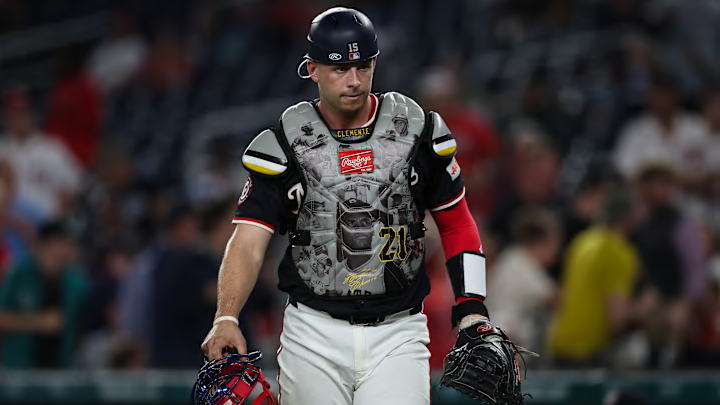The Washington Nationals wrapped up another disappointing season, finishing 66–96 and in last place in the NL East. For the first time in years, though, real changes are underway. The organization parted ways midseason with longtime manager Dave Martinez and general manager Mike Rizzo, and just hired 35-year-old Paul Toboni as President of Baseball Operations. As the front office takes shape under Toboni, the Nats still expect to add a new general manager.
With new leadership in place, the Nationals need a strong offseason to spur a step forward in 2026. That includes making tough roster decisions and moving on from players who no longer fit the team’s future plan.
Here are three Nationals who shouldn’t be back next season.
Riley Adams
The Nationals took a chance on Riley Adams in 2021 when they sent Brad Hand to Toronto. Unfortunately, Adams has never lived up to the hype that surrounded him as a prospect. Now 29, Adams is coming off one of his worst seasons in Washington.
He hit .188 with a .254 on-base percentage and a .312 slugging percentage over 256 at-bats. That added up to a .567 OPS, well below league average and one of the weakest lines on the roster. He also struck out in nearly 40 percent of his plate appearances, the highest rate on the team, and his pitch framing ranked near the bottom of qualified catchers.
Adams possesses some power, but there isn’t much to his game apart from the occasional home run. He underachieved as a below-average defender behind the plate throughout the season.
The emergence of Keibert Ruiz and Drew Millas from their injuries, with both likely ready for 2026, renders Adams expendable. Washington could look for another option at catcher this offseason, but even if it doesn’t, the team already has two better choices in place. Carrying a veteran with low upside and poor performance doesn’t make sense for a roster in a rebuild.
Orlando Ribalta
Bullpen problems have plagued the Nationals for years, and 2025 proved to be no exception. Washington shuffled through relievers as it grasped at stability, but too many arms failed to get the job done. One of them was Orlando Ribalta.
Ribalta, a 27-year-old Cuban right-hander drafted by Washington in 2019, finally got an extended look this season. At 6-foot-7 he looked the part of a power reliever, but the results came up lacking. In 24.1 innings he posted a 7.03 ERA and a 1.85 WHIP, walking 17 and striking out 25. His 6.3 walks per nine innings were well above the league average, which only made the Nationals’ bullpen woes worse. The group finished dead last in ERA for the year. Most of his outings came with traffic on the bases, and he never showed the command needed to stick in the majors.
If the Nationals want to compete in 2026, the bullpen must be rebuilt from the ground up. That means cutting ties with lackluster pitchers. Ribalta’s performance lacks the upside to justify another chance, and with younger options in the system, his spot should go to someone else. The offseason and free agency will be critical for Washington to bring in reliable bullpen arms and finally turn this weakness into a strength.
Paul DeJong
The Nationals signed Paul DeJong to a one-year, $1 million deal last February, hoping he could provide some veteran power and steady defense in the infield. Instead, his play for the Nats only showed how far his game has slipped since his All-Star days in St. Louis.
DeJong batted .228 with a .269 on-base percentage and a .373 slugging percentage over 193 at-bats. He added six home runs and 23 RBIs, but the production fell well short of what Washington needed. His .642 OPS fell in line with the underperformance that led the White Sox and Royals to move on from him in 2024. He struck out often, rarely walked, never looked like a consistent threat at the plate, and was a below-average fielder. Defensive metrics back that up, as he graded in the negatives in both Defensive Runs Saved and Outs Above Average.
The decline has been steady since his 30-homer season in 2019, and at age 32 there’s little reason to expect a turnaround. For the Nationals, 2026 should be about giving at-bats to younger infielders who might lead the team into the future. Keeping DeJong around would only block that path. DeJong may have been a low-cost signing, but turned out not to be a bargain for the Nats. There’s no upside in bringing him back for another year.
